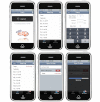Using smartphone technology to monitor physical activity in the 10,000 Steps program: a matched case-control trial
- PMID: 22522112
- PMCID: PMC3376516
- DOI: 10.2196/jmir.1950
Using smartphone technology to monitor physical activity in the 10,000 Steps program: a matched case-control trial
Abstract
Background: Website-delivered physical activity interventions are successful in producing short-term behavior change. However, problems with engagement and retention of participants in these programs prevent long-term behavior change. New ways of accessing online content (eg, via smartphones) may enhance engagement in these interventions, which in turn may improve the effectiveness of the programs.
Objective: To measure the potential of a newly developed smartphone application to improve health behaviors in existing members of a website-delivered physical activity program (10,000 Steps, Australia). The aims of the study were to (1) examine the effect of the smartphone application on self-monitoring and self-reported physical activity levels, (2) measure the perceived usefulness and usability of the application, and (3) examine the relationship between the perceived usefulness and usability of the application and its actual use.
Methods: All participants were existing members of the 10,000 Steps program. We recruited the intervention group (n = 50) via email and instructed them to install the application on their smartphone and use it for 3 months. Participants in this group were able to log their steps by using either the smartphone application or the 10,000 Steps website. Following the study, the intervention group completed an online questionnaire assessing perceived usability and usefulness of the smartphone application. We selected control group participants (n = 150), matched for age, gender, level of self-monitoring, preintervention physical activity level, and length of membership in the 10,000 Steps program, after the intervention was completed. We collected website and smartphone usage statistics during the entire intervention period.
Results: Over the study period (90 days), the intervention group logged steps on an average of 62 days, compared with 41 days in the matched group. Intervention participants used the application 71.22% (2210/3103) of the time to log their steps. Logistic regression analyses revealed that use of the application was associated with an increased likelihood to log steps daily during the intervention period compared with those not using the application (odds ratio 3.56, 95% confidence interval 1.72-7.39). Additionally, use of the application was associated with an increased likelihood to log greater than 10,000 steps on each entry (odds ratio 20.64, 95% confidence interval 9.19-46.39). Linear regression analysis revealed a nonsignificant relationship between perceived usability (r = .216, P = .21) and usefulness (r = .229, P = .17) of the application and frequency of logging steps in the intervention group.
Conclusion: Using a smartphone application as an additional delivery method to a website-delivered physical activity intervention may assist in maintaining participant engagement and behavior change. However, due to study design limitations, these outcomes should be interpreted with caution. More research, using larger samples and longer follow-up periods, is needed to replicate the findings of this study.
©Morwenna Kirwan, Mitch J Duncan, Corneel Vandelanotte, W Kerry Mummery.
Conflict of interest statement
None declared.
Figures


References
-
- Virot P. World Health Organization. 2011. Sep, [2012-03-26]. 10 Facts on Physical Activity http://www.who.int/features/factfiles/physical_activity/en/
-
- World Health Organization. 2011. [2012-03-27]. Physical Inactivity: A Global Public Health Problem http://www.who.int/features/factfiles/physical_activity/en/
-
- Centers for Disease Control and Prevention Guidelines for school and community programs to promote lifelong physical activity among young people. Centers for Disease Control and Prevention. MMWR Recomm Rep. 1997 Mar 7;46(RR-6):1–36. http://www.cdc.gov/mmwr/preview/mmwrhtml/00046823.htm - PubMed
-
- King AC, Sallis JF, Dunn AL, Simons-Morton DG, Albright CA, Cohen S, Rejeski WJ, Marcus BH, Coday MC. Overview of the Activity Counseling Trial (ACT) intervention for promoting physical activity in primary health care settings. Activity Counseling Trial Research Group. Med Sci Sports Exerc. 1998 Jul;30(7):1086–96. - PubMed
Publication types
MeSH terms
LinkOut - more resources
Full Text Sources
Medical

